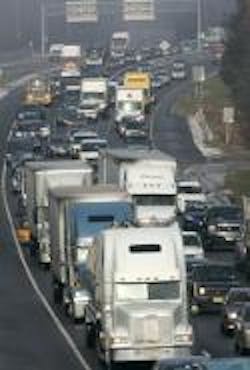“This is exciting news, but there are still far too many people dying in traffic accidents. Drivers need to keep their hands on the steering wheel and their focus on the road in order to stay safe.” –U.S. Transportation Secretary Ray LaHood. “
“Dichotomy” is a derivation of a Greek word meaning a division into two mutually exclusive, opposed, or contradictory groups, and it’s quite apropos in light of the announcement by the Department of Transportation (DOT) that overall traffic fatalities reported at the end of 2009 reached the lowest level since 1954 even as the wife and adult daughter of Senate Majority Leader Harry Reid (D-Nevada) were severely injured on I-95 just south of Washington, D.C., when their Honda Odyssey minivan got rear-ended by a tractor-trailer.
I mean, here we are looking at the 15th consecutive quarterly decline in highway fatalities, with the highway death count in 2009 projected to come in at 33,963, a drop of 8.9% as compared to the 37,261 deaths reported in 2008, and it’s almost a foregone conclusion that it’ll overshadowed by the tragedy now engulfing the Reid family.
Landra Reid, the Senator’s wife, suffered a broken neck, broken back and broken nose, while his daughter Lana Reid sustained a neck injury and facial lacerations. Though neither is expected to require surgery, they’ll no doubt both face a long road to recovery (and this reporter is sending his hopes and prayers to them.)
The driver of the tractor-trailer, Alan W. Snader, 59, of Ohio, was charged with reckless driving, according to initial reports, and that doesn’t surprise me either – anyone driving on I-95 knows it’s infamous for “stop-and-go” traffic, going from 70 mph to a dead stop, then unwinding again like some bizarre accordion. Truckers I’ve met that frequent this strip of asphalt are always on the alert – day or night – for such abrupt slowdowns as it can prove calamitous if they’re not; proved by this crash involving the Reid family.
Still, despite this incident, we can’t lose sight of the larger picture here: that highway safety is dramatically improving, and from my perspective, outside of the pure economic factor of people driving less because they are conserving precious dollars in recessionary times.
[In a related note, check out the speech by Indiana Governor Mitch Daniels in December last year, when he noted that his state’s 2009 traffic fatalities were on pace to be the lowest recorded since 1925 and a more than 16% drop from 2008. Those are stats he rightly praises.]
In a nice piece by the USA Today newspaper, Robert Poole, director of transportation policy at the Reason Foundation think tank, said the decline in traffic fatalities is not recession-driven but "a genuine improvement" in road safety.
"This is not because of the economy," he told the newspaper. "If the rate per vehicle mile traveled is at such a low rate, that's independent of how many people are out there. Then you have to look at what could contribute to that." He’s referring to the projected decrease in the rate of highway fatalities, to 1.16 fatalities per 100 million Vehicle Miles Traveled (VMT); down from 1.25 fatalities per 100 million VMT in 2008.
However, Barbara Harsha, executive director of the Governors Highway Safety Association, told the newspaper that more time is required to see if this fatality decline holds firm as a trend.
“It takes a minimum of three years, and preferably five years, of (non-recession) declines before you can say that (the roads are safer),” she stressed.
The National Highway Traffic Safety Administration (NHTSA) attributes these declines in fatalities to a combination of factors that include: high visibility safety campaigns like Click It or Ticket to increase seat belt use, tougher enforcement of state laws to prevent drunk driving and distracted driving, as well as safer roads, safer vehicles and motorists driving less.
NHTSA’s data shows that the Click It or Ticket campaign helped push overall seat belt usage in the U.S. from 67% of drivers in 1999 to 83% in 2008, while drunken-driving crackdowns helped cut impaired-driving deaths from 15,935 — 38% of the total — in 1998, to 11,773, 32% of the total in 2008.
“This continuing decline in highway deaths is encouraging, but our work is far from over,” noted NHTSA’s chief, David Strickland. “We want to see those numbers drop further. We will not stop as long as there are still lives lost on our nation’s highways. We must continue our efforts to ensure seat belts are always used and stay focused on reducing distracted and impaired driving.”
[Better driving is called for, as well. Utah’s Desert News put a nice video report together with the help of the Utah Highway Patrol on the issue of “overcorrection” and how this flaw in driving behavior increases the risk of a crash.]
He’s getting support for this view from industry groups, too.
“Although Americans drove slightly more in 2009 than they did in 2008, fatalities dropped by nearly 9%,” noted Greg Cohen, president & CEO of the American Highway Users Alliance. “We are pleased with the progress being made, but … we must not lose sight of the fact that car crashes are still the number one cause of death for children and young adults. Let's keep making progress on this epidemic until we can celebrate zero deaths on our roads.”
It’s a tall order, but doable, I think, if all drivers – everyday motorists and truckers alike – try to take their performance behind the wheel up another notch.
